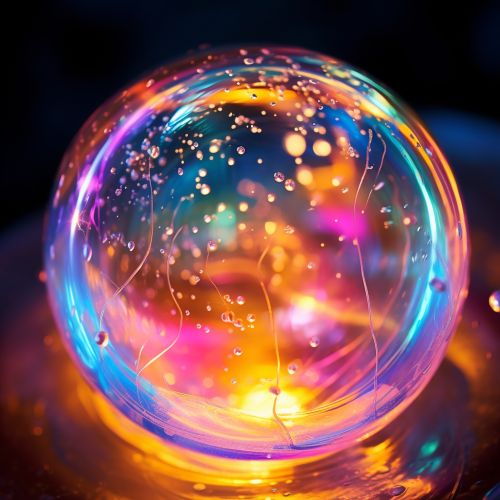Iridescence
Introduction
Iridescence is a fascinating optical phenomenon that causes certain surfaces to appear to change color as the angle of view or the angle of illumination changes. This effect is often seen in nature, on the surfaces of bubbles, butterfly wings, and certain types of minerals and gemstones. The term comes from the Greek word "iris", which means rainbow, and is related to the goddess Iris, who was the personification of the rainbow in Greek mythology.


Physics of Iridescence
The phenomenon of iridescence is a result of a process called interference, which occurs when two or more waves combine to form a new wave. In the case of iridescence, this interference is caused by the reflection of light off of a surface and the subsequent interaction of the reflected waves.
When light hits a surface, some of it is absorbed, some is transmitted, and some is reflected. The reflected light waves can then interfere with each other, either constructively (adding together to form a brighter wave) or destructively (canceling each other out). This interference can produce a range of colors, depending on the wavelength of the light and the angle at which it hits the surface.
Iridescence in Nature
Iridescence is commonly observed in the natural world, particularly in the animal kingdom. For example, many species of birds and insects have iridescent feathers or scales. This is often due to the presence of microscopic structures on their surfaces that interfere with light, causing it to be reflected in different colors.
One of the most well-known examples of iridescence in nature is the peacock's tail. The vibrant colors of the peacock's feathers are not caused by pigments, but by microscopic structures that reflect light at different angles. Similarly, the wings of certain butterflies, such as the Morpho butterfly, are covered in tiny scales that reflect light in such a way as to produce an iridescent effect.
Iridescence is also observed in the plant kingdom. Some types of flowers, for example, have iridescent petals that can change color depending on the angle of view. This is thought to help attract pollinators.
Iridescence in Minerals and Gemstones
Many minerals and gemstones also exhibit iridescence, including opal, labradorite, and moonstone. In these cases, the iridescence is caused by the interaction of light with the internal structure of the mineral or gemstone.
For example, in opals, the iridescence is caused by the presence of tiny spheres of silica, which diffract light and produce a range of colors. The exact colors observed depend on the size and arrangement of the silica spheres.
Iridescence in Art and Culture
Iridescence has been used in art and design for thousands of years. Ancient cultures, including the Romans and Egyptians, used iridescent materials such as mother-of-pearl and beetle wings in their artwork. In modern times, iridescence is often used in jewelry, fashion, and industrial design.
In addition to its aesthetic appeal, iridescence has also been used symbolically in various cultures. For example, in some Native American cultures, the iridescent feathers of certain birds are considered sacred and are used in ceremonial dress.
